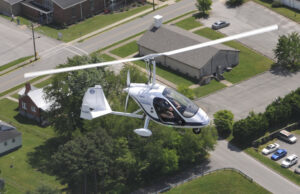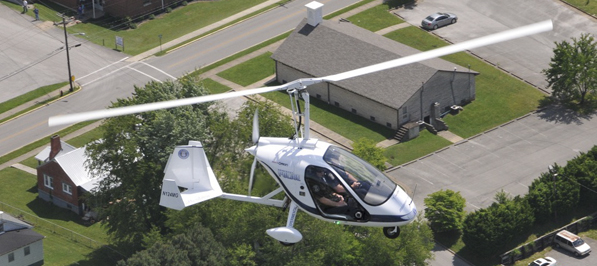At the inaugural 2012 Somernites Cruise weekend April 25 and 26, the thousands of muscle car enthusiasts packed into downtown Somerset, Ky. might not have seen the small, white helicopter-like aircraft quietly patrolling the skies above them.
But Lt. Shannon Smith of the Somerset Police Department certainly saw them—from the pilot’s seat of the two-seat Magni M24 Orion Gyroplane.
 From that vantage point, Smith spotted reckless drivers and helped officers below in patrol cars locate those drivers without having to pursue them at high speeds.
From that vantage point, Smith spotted reckless drivers and helped officers below in patrol cars locate those drivers without having to pursue them at high speeds.
“It really increases the safety of the officers, the suspects, and the public,” Smith said of the aircraft’s capabilities displayed during this first mission. “We consider it a success.”
And they are just getting started.
Thanks to a national law enforcement program operated by The Center for Rural Development, the Somerset Police Department has become the first law enforcement agency in America to test and evaluate the Italian-made gyroplane, and only the second U.S. law enforcement agency to use this style of aircraft for police operations.
Through an agreement with the Small, Rural, Tribal and Border Regional Center (SRTB-RC)—a component of the National Institute of Justice’s National Law Enforcement and Corrections Technology Center (NLECTC) system—the Somerset Police Department has the gyroplane at its disposal at no cost until the end of July for police activities.
Following the testing and evaluation period, the department can choose whether it will fund the aircraft and continue aviation operations.
Activities to be undertaken with the gyroplane during the testing and evaluation period include traffic enforcement, search and rescue, traffic flow monitoring during special events, aerial photography, and counter-drug operations.
Because of the gyroplane, a city the size of Somerset with just over 11,000 residents now has capabilities primarily available in larger, more metropolitan cities, according to Acting Somerset Police Chief Major Doug Nelson.
“This partnership between the U.S. Department of Justice, The Center for Rural Development, the Small, Rural, Tribal and Border Regional Center, and the Somerset Police Department gives us the ability to see how an aviation program will work for us.”
Acting Somerset Police Chief Doug Nelson
Smith, who has 12 years of aviation experience and 1,950 hours of flight time in 20 different types of aircraft, will fly the gyroplane to help protect Somerset’s critical infrastructure from natural or manmade hazards.
This includes the city’s water plant that provides drinking water to 100,000 customers daily, and its 135-mile natural gas pipeline that serves six counties in Southeastern and Central Kentucky.
“The Somerset Police Department is responsible for protecting the City of Somerset and its infrastructure,” Nelson said. “The rough Eastern Kentucky terrain makes inspection and protection of our natural gas pipeline difficult without an aircraft.”
Though similar in appearance to a helicopter, a gyroplane does not have a powered rotor. It instead uses a free-spinning rotor to generate lift, called autorotation.
The rotor is kept spinning by wind forces, and the thrust from the gyroplane’s engine and propeller allows it to take off and land on a runway like a traditional airplane.
Once airborne, it can reach speeds of up to 100 MPH. It can also appear to hover with slow to no forward speed while slowly descending.
The experimental aircraft is not a replacement for all helicopter missions due to the inability to take off and land vertically and weight restrictions on what it can carry.
However, for the missions it can perform, a gyroplane is very cost effective. A traditional police helicopter costs anywhere from $500,000 to $4 million fully equipped, and operational costs can average over $1,000 per hour.
In contrast, the Magni gyroplane costs about $110,000 and about $40 an hour to operate using regular gas just like a car. Those costs are less than purchasing and operating three fully equipped patrol cars.
“It didn’t take long for us to realize the advantage gyroplanes give law enforcement agencies that don’t have large budgets,” Nelson said. “Their low purchase price and low cost per hour makes them ideal for any public safety agency.”
The aircraft is part of the Law Enforcement Aviation Technology program, an arm of the U.S. Department of Justice’s National Institute of Justice. The aviation program is administered nationally by SRTB-RC through The Center in Somerset.
The Somerset Police Department is the latest partner in the aviation technology program, which has stationed 17 light-sport aircraft with law enforcement agencies across the nation for testing and evaluation purposes in police operations.
Even though it is a national program, SRTB-RC remains committed to serving law enforcement agencies in The Center’s 42-county primary service area in Southern and Eastern Kentucky, according to SRTB-RC Executive Director Dave Mather.
The new partnership with the Somerset Police Department and the Magni gyroplane exemplifies this commitment, Mather said.
“Our program provides technology support to small and rural law enforcement across the United States, but this program was perfectly suited for the Somerset Police Department,” Mather said.
“We had the right conditions, right aircraft, and an experienced pilot in Lieutenant Smith to be able to conduct meaningful research into the use of the gyroplane in support of law enforcement,” Mather said. “I’m thrilled this combination was right here in Somerset.”
Smith agreed.
“Without (SRTB-RC) being in our backyard, this situation probably wouldn’t have happened,” Smith said. “We were at the right place at the right time.”
“The safety of our residents and those we serve outside our city limits is a top priority,” Nelson added. “We are thankful for this partnership, and are proud to have a modern, safe, and efficient aircraft to serve our community and its resources.”
Funded through a cooperative agreement between the U.S. Department of Justice, Office of Justice Programs, National Institute for Justice, National Law Enforcement and Corrections Technology Center, and The Center for Rural Development, SRTB-RC serves as an honest broker providing responsive solutions and practical benefits to small and rural law enforcement agencies and acting as a one-stop-shop for free technical assistance and access to other NIJ Centers for nearly 17,000 small, rural, tribal, and border agencies across the nation through innovative, collaborative cooperation.
For more information on SRTB-RC and its programs, contact Executive Director Dave Mather at 606-677-6000, or visit www.srtbrc.org.
[flickrset id=”72157629724761938″ thumbnail=”square” photos=”” overlay=”true” size=”square”]




